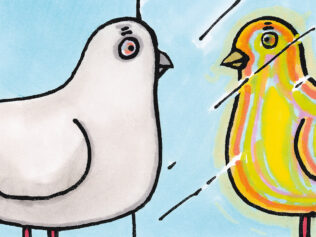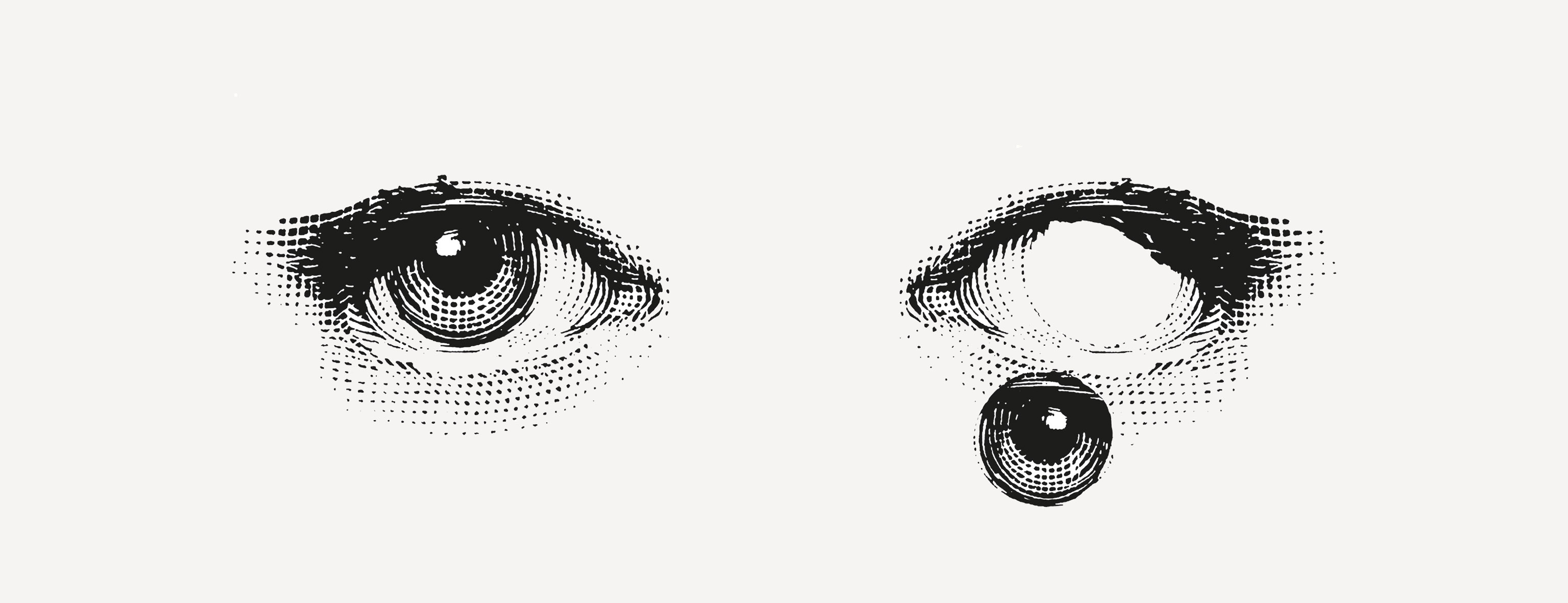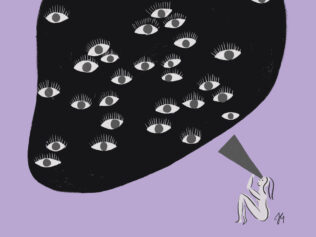
Majestic and spectacular, and at the same time fleeting and private. They stretch across the sky, yet only exist in a single point. Rainbows—everyone sees them differently.
Pale green hills dazzle against a lead-gray sky. In the foreground, two beggar girls sit on the grass. One has just turned her head to look over her shoulder. Behind her, a double rainbow extends over the nearby buildings. The second girl, older, has her eyes closed and her chin slightly raised, as if listening to something in the distance, an act of flamboyant disdain for the colorful phenomenon. The secret is revealed by the title of the painting by John Everett Millais: “The Blind Girl.”
The sun, seeming to shine from behind the observer, warms the blind girl’s face. She is calm, combing the soft grass with one hand, and squeezing her companion’s hand with the other. Although the expression on the other girl’s face is not visible, one can guess that it is full of delight, perhaps tainted with fear at the sight of the storm clouds behind the rainbow. On the one hand, immersion in a nature devoid of light; on the other, fascination with a dramatic weather spectacle. Looking at this picture, we can’t help but wonder which of these experiences would allow us to “see” more. Millais gives his answer: on closer inspection, the sign hanging around the older girl’s neck reads “Pity the blind.”
Dual Arcs
A skilled eye will quickly notice the painter’s precision. Perched on the roofs of the village, the rainbow appears opposite the direction from which the sun is shining—exactly as it should be. It is a double rainbow; in fact, almost every rainbow is accompanied by a faint, paler copy. The color order of the outer arc in Millais’s painting is the reverse of the inner arc, just like in reality. Interestingly, the artist initially painted both rainbows the same way, with red at the top of the arcs. He made the change later in order to present the optical phenomenon correctly according to the laws of physics.
However, there is something else in Millais’s painting that becomes clearer after considering how rainbows are formed. The rainbow often features in paintings and texts as something tangible, constructed of a mysterious, luminous material. This is the case in Greek mythology, where the rainbow is personified by the goddess Iris, and similarly in Norse legends, where the rainbow is a bridge guarded by Heimdall that leads to the realm of the gods, Asgard. However, a rainbow is in fact not a physical object, but a projection created when light is bent and scattered by water droplets hanging in the air. Therefore, each person sees a specific rainbow, and the rays of light that comprise the arc reach each person’s eyes differently. Two people standing side by side will see it in a slightly different space, perhaps with varying tone or intensity. We “see” the rainbow from “The Blind Girl” as observers of the whole scene. This means that the young girl with her head turned away sees a different rainbow, her own; it is one that the viewer will never see, for they would have to become that girl, enter the picture, abandon the role of observer.
Personal Rainbow
For a long time, the idea of having one’s “own” rainbow struck me as something completely abstract. It is hard to accept that a “structure” the size of a rainbow, linking the sky with the earth, could be something ephemeral, no more real than the “sunbeams” projected onto a wall by a mirror being twisted back and forth. Despite its apparent size, the rainbow is a fleeting mirage, the product of two interacting components—light, and the water contained in the atmosphere—its beauty reserved for a single viewer.
It was a fascinating stroke of the obvious that made me aware of this property of rainbows during a late afternoon flight from Munich to Kraków. As the plane neared its destination and began to descend, it cut through a bank of cumulonimbus clouds and into the dense sheet of rain beneath—all in the bright orange glow of the setting sun.
At that point, the passengers and crew became participants in a spectacular physics experiment showing what a rainbow looks like when observed not from the ground—which usually obscures the rainbow’s lower half—but from the air. Yes, rainbows have a second half. This is generally invisible to us, because the ground we walk on hinders us from seeing it. A complete rainbow is a perfect circle, centered on the axis connecting our eye to the sun. And this is precisely what met my eyes (and every other pair of eyes looking out of the plane’s window during that flight—each slightly differently, of course).
The light of the sun approaching the horizon behind the plane was already yellow-orange, not white, so the rainbow did not have its usual multicolored appearance. Filtered out from the sunlight, the cold colors—blue and purple—were not visible, but the rainbow still looked spectacular. A glistening halo appeared around the nose of the plane, a complete circle painted in red, yellow, and soft strokes of green. Since this rainbow was mine, personal, private, it floated along with me and the plane. Although it seemed at every second that we would fly through it like a huge hula-hoop, the circle remained perfectly still in front of the nose of the plane and accompanied us almost all the way to landing, when its lower half was absorbed by the runway as it slid suddenly beneath the aircraft.
From Raindrop to Eye
Even when only half-visible, rainbows always make a colossal impression. Misunderstandings about them also abound. It is commonly believed that in order for a rainbow to be seen, it must be both raining and sunny. In simplified terms, this is true: besides sunlight, the creation of a rainbow relies on water being dispersed in the atmosphere. However, this does not guarantee that the phenomenon will appear every time the sun peeks out from behind the clouds on a rainy day.
The formation of a rainbow is caused not by water droplets suspended in the air around us, but in front of us. While standing in a downpour, we are unlikely to see a rainbow, even if the sun is out. But it is a different story when the air in front of us—even at a considerable distance—is filled with a suspension of tiny water droplets, whether falling as torrential rain, or sprayed into the air by a waterfall or fountain.
As the light enters each tiny water molecule, it is refracted and reflected internally, then refracted again, before flying out of the water droplet and hurtling towards the observer. This whole process takes place in each illuminated droplet, but only some of them are in just the right position with respect to the observing eye that they create the image of an arc of light. Because light of different wavelengths (and therefore different colors) refracts at the boundary between water and air at a slightly different angle, the white sunlight is split. Each color leaves the droplet at a slightly different angle relative to the direction of the sun’s rays—from 40.5° for violet to 42.4° for red. This rather specific combination of the positioning of the sun and water molecules is one of the reasons why rainbows tend to appear in the late afternoon or early morning. That is when the sun is low in the sky, so the chances of its rays illuminating a band of water droplets located directly in front of us are greater.
Another half-truth is the idea that the sun must be shining for the creation of a rainbow. One night in July, I unintentionally put this assumption to the test. I was on a nighttime owl-spotting walk with a group of friends in the Alpine village of Villa di Chiavenna on the border between Italy and Switzerland. The moon, almost full, hung low over the mountains. When we reached the small Acquafraggia waterfall, I was surprised to see a faint rainbow gleaming in the fog that enveloped the falling water. Its colors were muffled, somehow colder, but what I saw was a true rainbow—only it was created by the moonlight, not the sun.
Hello, Halo!
Even more interesting effects can be observed when the sun or moon shine through a veil of thin, delicate clouds suspended so high in the atmosphere that they are composed not of water but of ice crystals. These types of clouds include cirrus and cirrostratus, and they often evade attention, looking like a thin haze or whitish fibers floating in the sky. However, because they are made of tiny ice crystals with a very well-defined, hexagonal symmetry, they act like clouds of diamond dust, tiny prisms that diffract the light in a very specific way. From the physics perspective, the phenomena they create are as “personal” as rainbows. A given person sees an image projected by carefully selected ice crystals, precisely those that bend the sun’s rays towards that particular observer. The marriage of frozen water and light creates one of the most unusual celestial spectacles: a halo.
In fact, the halo is not really a single phenomenon, but several. The most common, and also the easiest to miss, is the 22° halo—a circle of light with that exact angular radius, formed around the sun or the moon due to the presence of chaotically scattered ice crystals with a rod-like structure (elongated, hexagonal prisms). This kind of halo often goes unnoticed, because it is typically hidden in the blinding glow of the sun or moon. However, it is worth taking a peek at the sky from time to time when its blue (or black, at night) is obscured by a thin layer of transparent clouds—especially since halos are not just circles of light.
In the most extreme cases, this phenomenon can turn the sky into an ominous spectacle, a kaleidoscope of reflections, glare, and the bright outlines of bewildering patterns and shapes. It all depends on how the water—trapped within the ice “diamonds” of the feathery clouds—is positioned relative to the sun and the observer. If the cloud contains microscopic ice pyramids, one might see a Bottlinger’s ring—an oval halo around the sun, making it look like a surreal eye. Flat ice plates oriented horizontally in relation to the observer will cause a phenomenon known as a sun dog, where the sun is flanked by fainter copies, often adorned with horizontal “whiskers.” In ancient times, this phenomenon was interpreted as a vision of the supposed site of Jesus’s crucifixion, Golgotha (with a large sun cross in the center and two smaller ones on either side).
Meanwhile, structured crystals oriented horizontally are responsible for Parry arcs—concave eruptions of light above (or less commonly, below) a circular 22° halo. There are many more possible configurations of ice, light, and air currents, and the complete list of light projections comprises a complex mirage of glowing lines and intersecting paths. It is hardly surprising that in ancient times, such phenomena were treated as a bad omen, a harbinger of great or dramatic events, a divine sign, or even a prelude to the apocalypse. It is known today that halos are simply a coincidence of several physical circumstances—although many details of the processes that take place are still unknown.
A Vision at Zawrat Pass
One winter’s morning, as I was hiking with two companions through the Zawrat Pass in the Tatra Mountains, the wind blowing from the Dolina Pięć Stawów valley whipped up a storm of dry snow and ice. In the frosty air, the cloud of water in the form of hexagonal crystals created the most extraordinary halo I have ever observed. I knew that phenomena of this kind can arise both as a result of high cirrus clouds, and so-called “diamond dust”—ice particles suspended low in the atmosphere. But that day in the Tatras I saw it all: a shimmering round halo, a Parry arc, a sun dog, and even a parhelic circle—a horizontal line of light seemingly threaded through the sun.
The most interesting thing about this phenomenon, however, was not its fantastic pomp, but just how very personal it was. The two climbers with me had to bend this way and that, craning their necks to get into my line of sight and see in the same detail what I was seeing. I suppose that’s why optical phenomena in the sky always evoke in me a kind of yearning that is impossible to measure or name. After all, it is highly poetic that pure, cold physics constructs the world in such a way that everyone can see their very own, personal rainbows, halos, and mountain spectra. One could even say that in this case, physics brings humans closer together, for it is only by perfectly adopting the perspective of someone else that one person can see these phenomena in the same way as another.
Translated from the Polish by Kate Webster









